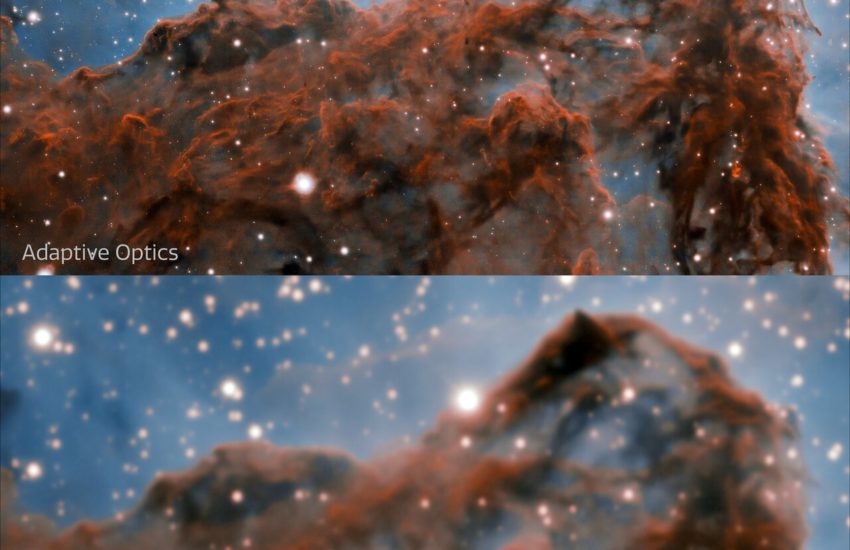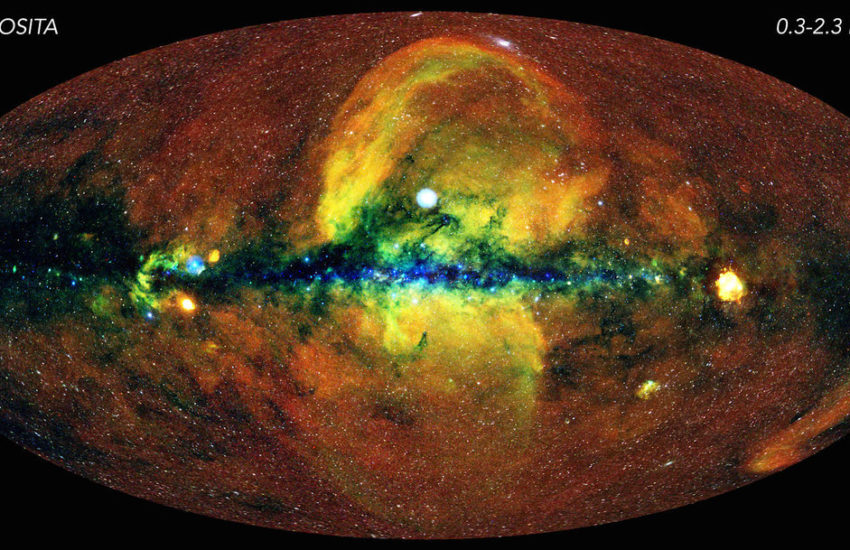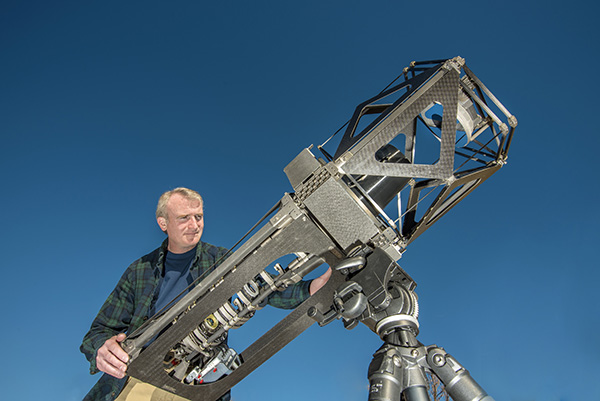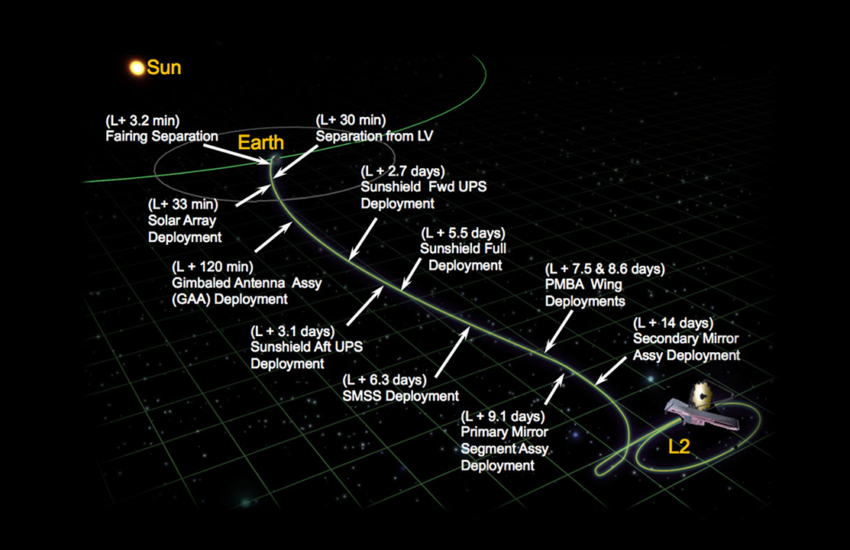Category: Telescopes
-

Comparison of images with and without Adaptive Optics
Adaptive optics control the surfaces of a telescope’s optic – often the main mirror – to take into account the turbulence in the Earth’s atmosphere. By doing this, the distortion caused by the “twinkling” we can even see when we look at stars with our eyes alone can be removed. This image shows a comparison…
-

CSIRO Parkes radio telescope added to National Heritage List – CSIRO
The iconic Parkes radio telescope, otherwise known as The Dish, has been officially recognised for its contribution to Australian astronomy and humankind’s understanding of the Universe with its addition to the National Heritage List. Source: www.csiro.au/en/News/News-releases/2020/CSIRO-Parkes-radio-telescope-added-to-National-Heritage-List
-

eROSITA X-Ray Telescope Captures Hot, Energetic Universe
eROSITA X-Ray Telescope Captures Hot, Energetic Universe | Astronomy | Sci-News.com A new all-sky image from the eROSITA X-ray telescope onboard the Spectrum-Roentgen-Gamma (SRG) space observatory contains over one million objects, about half of which are new to astronomers. It shows the structure of hot gas in the Milky Way itself, and the…
-

ESOblog: Twinkle, twinkle little star, but not on our watch
ESOblog: Twinkle, twinkle little star, but not on our watch Great blog article from the ESO on adaptive optics – mechanical systems to deform the shape of a mirror to take into account disturbances in the Earth’s atmosphere. The same sort of disturbances that cause stars to “twinkle”. Astronomers have turned to a method…
-

James Webb Space Telescope will “absolutely” not launch in March
On Wednesday, the chief of NASA’s science programs said the James Webb Space Telescope will not meet its current schedule of launching in March 2021. Looks like the James Webb Space Telescope is still some time away. Launch in 20210? Who knows! “This team has stayed on its toes and pushed this telescope forward.”…
-

What is a Plossl eyepiece?
What is a Plössl eyepiece? Plossl are some of the most popular low cost eyepieces for telescope users. A good explanation! Source: www.skyatnightmagazine.com/advice/what-is-a-plossl-eyepiece/
-

Sandia National Laboratories: Seeing stars
Sandia National Laboratories: Seeing stars Sandia team designs a new way for additive manufacturing Source: www.sandia.gov/news/publications/labnews/articles/2018/16-02/telescope.html
-

James Webb Space Telescope Post-Launch Deployment Timeline
1ST HOUR: Starting at liftoff, the Ariane rocket will provide thrust for a little over 8 minutes. Webb will separate from the Ariane V launch vehicle a half hour after launch and we will deploy the solar array immediately afterward. We will also release several systems that were locked for launch. 1ST DAY: Two hours…
-
Yerkes Observatory future to be discussed Feb. 25
Yerkes Observatory future to be discussed Feb. 25 at Williams Bay High School WILLIAMS BAY — Future plans for Yerkes Observatory could be presented later this month at a public meeting at Williams Bay High School. Source: www.lakegenevanews.net/news/local/yerkes-future-could-become-clearer-feb-in-williams-bay/article_02135bb9-59f0-5cb4-9469-d2dfa2f3ceb5.html
-
Schmitt-Cassegrain Collimation Made Easy Using a Duncan Mask | Alpha Lyrae
Schmitt-Cassegrain Collimation Made Easy Using a Duncan Mask | Alpha Lyrae Very simple method of achieving excellent collimation of a Schmitt-Cassegrain using a home made Duncan Mask. Source: alpha-lyrae.co.uk/2013/12/31/schmitt-cassegrain-collimation-made-easy-using-a-duncan-mask/
-
Thirty Meter Telescope forges ahead with Canary Islands site – Physics World
Thirty Meter Telescope forges ahead with Canary Islands site – Physics World Officials at the protest-hit telescope seek a construction permit for the island of La Palma Source: physicsworld.com/a/thirty-meter-telescope-forges-ahead-with-canary-islands-site/
-
Goodbye Aberration: Physicist Solves 2,000-Year-Old Optical Problem
Goodbye Aberration: Physicist Solves 2,000-Year-Old Optical Problem When you look through your viewfinder and things seem a little bit blurry or lacking definition, it’s probably because you are using an “el cheapo” lens. Source: petapixel.com/2019/07/05/goodbye-aberration-physicist-solves-2000-year-old-optical-problem/
-
Deteriorating Kepler Space Telescope Refuses To Die
Unwilling to to go quietly into that good night, the Kepler Space Telescope is once again gathering scientific data — despite a malfunctioning thruster and painfully low levels of fuel…. Source: www.gizmodo.com.au/2018/09/deteriorating-kepler-space-telescope-refuses-to-die/
-
A $1 billion telescope that will take pictures 10 times sharper than Hubble’s is now officially under construction
They’ve started building the GMT!!! A $1 billion telescope that will take pictures 10 times sharper than Hubble’s is now officially under construction In astronomy, cutting-edge technology often begins with a bunch of bulldozers, busted rocks, and dump trucks. Source: www.businessinsider.com.au/giant-magellan-telescope-gmt-construction-2024-completion-2018-8?r=US